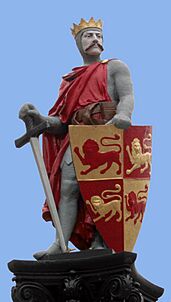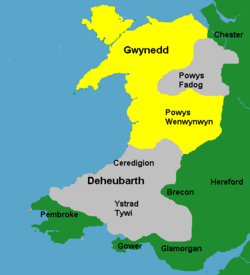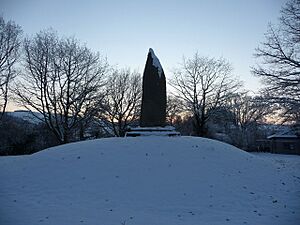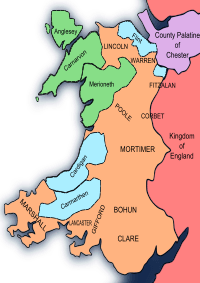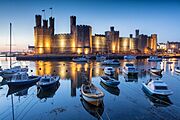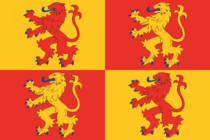Principality of Wales facts for kids
Quick facts for kids
Principality of Wales
Tywysogaeth Cymru (Welsh)
|
|||||||||||
|---|---|---|---|---|---|---|---|---|---|---|---|
| 1216–1283: Welsh rule (native) |
|||||||||||

Wales after the Treaty of Montgomery of 1267:
Gwynedd, Llywelyn ap Gruffudd's principality Territories conquered by Llywelyn ap Gruffudd Territories of Llywelyn's vassals Lordships of the Marcher barons Lordships of the King of England Kingdom of England |
|||||||||||
| Status | Sovereign state (1216–1283, 1294–1295, 1400–1415) Dependent territory of England (1283–1294, 1295–1400, 1415–1542) |
||||||||||
| Official languages | Anglo-Norman (until the mid-14th century) Middle English Middle Welsh |
||||||||||
| Religion | Christianity | ||||||||||
| Demonym(s) | Welsh, Cymreig | ||||||||||
| Government | Feudal Monarchy | ||||||||||
| Prince | |||||||||||
|
• 1216–1283
|
Llywelyn the Great and descendants | ||||||||||
|
• 1301–1542
|
Edward of Caernarvon and subsequent heirs to the English throne | ||||||||||
| Historical era | Middle Ages | ||||||||||
| 1216 | |||||||||||
| 1218 | |||||||||||
| 1267 | |||||||||||
| 1277 | |||||||||||
|
• Statute of Rhuddlan
|
3 March 1284 | ||||||||||
| 1294–1295 | |||||||||||
| 1400-1415 | |||||||||||
| 1535–1542 | |||||||||||
| Currency | penny (ceiniog) | ||||||||||
|
|||||||||||
| Today part of | |||||||||||
The Principality of Wales (Welsh: Tywysogaeth Cymru) was a special territory in Wales. It was first ruled by native Welsh princes from 1216 to 1283. At its largest, it covered about two-thirds of modern Wales between 1267 and 1277.
After England conquered Wales from 1277 to 1283, the English crown took control of parts of Wales. These areas, mainly in the north and west, became a new Principality of Wales. It was ruled by the English king or his heir. This Principality was not officially part of the Kingdom of England until the Laws in Wales Acts 1535 and 1542. After these laws, the Principality stopped being a separate area.
The first Principality was officially started in 1216 by Llywelyn the Great, a Welsh ruler from Gwynedd. He brought other Welsh leaders together at the Council of Aberdyfi. This agreement was later recognized by the Treaty of Worcester in 1218. This treaty was between Llywelyn the Great and Henry III of England.
The Principality had a lot of freedom. It had its own legal system based on old Welsh laws called Cyfraith Hywel. It also had a well-organized court system. Even though it promised loyalty to the English king, it was mostly independent. It was similar to the Kingdom of Scotland in how it related to the English Empire. Many people saw its existence as proof that Wales could become its own country.
This period of independence ended when Edward I of England conquered the Principality between 1277 and 1283. Under the Statute of Rhuddlan, the Principality lost its independence. It became a territory controlled by the English crown. From 1301, the English king's lands in north and west Wales were given to the heir to the throne. This heir was given the title "Prince of Wales". When that prince became king, the lands and title would join the Crown again. During this time, some Welsh leaders rebelled, but they did not succeed in gaining full independence.
Since the Laws in Wales Acts of 1535–1542, Wales has been fully part of the Kingdom of England. There is no longer a specific area called the "Principality" in Wales. However, the term is sometimes used informally to describe the country. It also refers to the honorary title of Prince of Wales.
Contents
How the Principality Began
The Principality of Wales was created in 1216 at the Council of Aberdyfi. Here, Llywelyn the Great was recognized as the main ruler among the Welsh princes. They all promised loyalty to him. Later, the King of England agreed to this, at least in part. He allowed Llywelyn's heirs to use the title "Prince of Wales." However, there were limits to Llywelyn's power and other rules, like promising loyalty to the King of England.
Llywelyn wanted to make sure his chosen heirs would follow a specific system of inheritance. This system, approved by the Pope, did not include sons born outside of marriage. Because of this, he excluded his older son, Gruffydd ap Llywelyn Fawr, from inheriting. This decision caused problems later on.
In 1240, Llywelyn died. Henry III of England quickly invaded and took over large parts of Llywelyn's former lands. But they made peace, and Henry gave Dafydd ap Llywelyn the title 'Prince of Wales'. This title was later given to Llywelyn's successor, Llywelyn, in 1267. Other members of the princely House of Aberffraw also claimed this title.
Aberffraw Princes: Welsh Rulers
Llywelyn ap Iorwerth (1195–1240)
By 1200, Llywelyn Fawr (the Great) ap Iorwerth ruled all of Gwynedd. England supported his control of these lands that year. Llywelyn married Joan, who was King John's daughter, in 1204. In 1209, Prince Llywelyn even joined King John in a military campaign in Scotland.
However, by 1211, King John saw Llywelyn's growing power as a threat. King John invaded Gwynedd and forced Llywelyn to give up some lands. Llywelyn also had to agree that John would be his heir if Llywelyn and Joan had no legitimate children. Welsh law was different, allowing children born outside marriage to inherit. Llywelyn had several such children.
Many Welsh allies left Llywelyn during England's invasion. They preferred a distant English king to a powerful Welsh ruler nearby. But King John built a castle at Aberystwyth and interfered directly in Welsh areas. This made many Welsh lords change their minds. Llywelyn took advantage of this anger and led a revolt against King John. The Pope even supported Llywelyn because King John was an enemy of the church.
In 1212, Llywelyn regained his lost lands and burned the castle at Aberystwyth. His revolt made King John delay his invasion of France. The King of France, Philip Augustus, even contacted Llywelyn to suggest an alliance against England. King John then ordered the execution of Welsh hostages, who were sons of Llywelyn's supporters.
Llywelyn I was the first prince to receive loyalty from other Welsh lords at the 1216 Council of Aberdyfi. This made him the true Prince of Wales.
Dafydd ap Llywelyn (1240–1246)
When Dafydd became ruler after his father, he immediately faced challenges from his half-brother, Gruffudd. Dafydd imprisoned Gruffudd. But his plans were stopped by an invasion from Henry III of England, who was allied with Gruffudd's supporters. In 1241, Dafydd gave in and signed the Treaty of Gwerneigron, which limited his power.
By 1244, Gruffudd had died. Dafydd then gained support from many of his brother's former followers. The Pope recognized him as Prince of Wales for a time. In 1245, he defeated Henry III in battle during England's second invasion of Wales. They agreed to a truce, and Henry left. But Dafydd died unexpectedly in 1246 without any children.
Llywelyn ap Gruffudd (1246–1282)
After defeating his brothers, Llywelyn took back the areas of Gwynedd that England had occupied. He allied with Simon de Montfort, 6th Earl of Leicester in 1265 against King Henry III of England. This allowed him to regain large parts of central Wales from the English lords.
At the Treaty of Montgomery in 1267, Llywelyn was given the title "Prince of Wales" for his heirs. He was also allowed to keep the lands he had conquered and receive loyalty from lesser Welsh princes. In return, he had to promise loyalty to the King of England and pay a large fee.
However, disagreements between Llywelyn, his brother Dafydd, and English lords led to new conflicts with England. England was now ruled by Edward I. After the Treaty of Aberconwy in 1277, Llywelyn's territory was greatly reduced. He joined a revolt started by his brother Dafydd in 1282 and died in battle.
Dafydd ap Gruffudd (1282–1283)
Dafydd took his older brother's title in 1282. He led a short period of continued resistance against England. He was captured and executed in 1283.
Life in the Principality: People and Culture
The Principality of Wales in the 13th century covered about three-quarters of modern Wales. It stretched from Anglesey to Machen. By 1271, Prince Llywelyn II ruled over about 200,000 people. This was almost three-quarters of the total Welsh population. The population grew across Europe in the 13th century, but it was even more noticeable in Wales.
By Llywelyn II's time, about 10 percent of the people lived in towns. Also, there were no longer "unfree slaves" within the Principality. More people meant the prince could gather a much larger army.
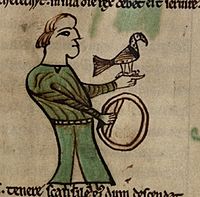
The stable environment created by the Aberffraw rulers helped Welsh culture grow. This was especially true in literature, law, and religion. Old traditions say that Gruffydd I improved the groups of bards (poets) and musicians. Welsh literature became very strong as new ideas reached Wales. Contact with other parts of Europe made Welsh people even prouder of their heritage.
Economy and Trade in Wales
The growth in population, especially in the Principality, led to a more varied economy. Records from Meirionnydd show 37 different jobs right before the conquest. These included eight goldsmiths, four professional bards, 26 shoemakers, a doctor, and a hotel keeper. There were also 28 priests, two of whom had gone to university. Many people were also fishermen, administrators, and craftsmen.
The average temperature in Wales was a bit warmer than today. This meant more land could be used for farming, which was very helpful for Wales. Important developments for the Principality included better trade routes. These routes brought new energy sources like the windmill, the fulling mill (for making cloth), and the horse collar (which made horses twice as efficient for pulling).
The Principality traded cattle, animal skins, cheese, timber, horses, wax, dogs, hawks, and wool. They also traded flannel, which became a major export. Flannel was second only to cattle in terms of exports. In return, Wales imported salt, wine, wheat, and other luxury goods from London and Paris. Most importantly for defense, iron and special weapons were also imported. England sometimes used Wales's need for imports to weaken the Principality during conflicts.
Wales Under English Rule (1284–1543)
How Wales was Governed
Between 1277 and 1283, Edward I of England conquered the lands of Llywelyn ap Gruffudd and the last native Welsh princes. The way the Principality was governed after the conquest was set out in the Statute of Rhuddlan in 1284. This law stated that the Principality was "joined and united" to the English crown.
The Principality was managed by the Prince of Wales's council. This council had 8 to 15 members and met in London or later in Ludlow. This council was the highest court for appeals in the Principality. By 1476, this council, known as the Council of Wales and the Marches, also became responsible for all of Wales.
The Principality's land was split into two main types: lands directly controlled by the king and lands Edward I had given to his supporters.
For the lands directly controlled by the king, the administration was divided into two areas: North Wales (based at Caernarfon) and West Wales (based at Carmarthen). The Statute of Rhuddlan created counties like Carmarthenshire and Cardiganshire in the west. These were managed by the Justiciar of South Wales. In the north, Anglesey, Merionethshire, and Caernarfonshire were created. These were controlled by the Justiciar of North Wales and a financial office at Caernarfon. Royal officials like sheriffs collected taxes and handled justice.

Another county, Flintshire, was created from other lordships. It was managed with the nearby English county of Cheshire.
The rest of the Principality included lands Edward I gave to his supporters after the conquest in 1284. These lands became like Marcher lordships. For example, the Lordship of Denbigh was given to the Earl of Lincoln. These lands were technically part of the Principality but acted mostly independently.
New Laws in Wales
The Statute of Rhuddlan also brought English common law to the Principality. However, some local differences remained. Criminal law fully became English common law. The law said that for crimes like theft, murder, and robbery, "they shall use the laws of England."
But Welsh law continued to be used for civil cases. These included things like land inheritance and contracts. However, there were changes. For example, sons born outside of marriage could no longer claim part of an inheritance, which Welsh law had allowed before.
In 1301, this changed Principality was given to the English king's heir. From then on, it became the land given to the heir to the throne.
The English parliament rarely made laws for Wales. The lands of the Principality were mainly subject to laws made by the king and his council. However, the king would let Parliament make laws in emergencies, like during a rebellion. An example is the Penal Laws against Wales 1402. These laws were made to stop the Welsh Revolt led by Owain Glyndŵr. They stopped Welsh people from marrying English people or owning land in England. Some Welsh people who were loyal to the king successfully asked to be excused from these laws.
Castles, Towns, and New Settlers
After the conquest, Edward's main goal was to make his new territories safe. Stone castles were the key to this. Under the direction of James of Saint George, Edward's master-builder, many impressive castles were built. These castles had unique designs and the best defenses of the time. They formed a "ring of stone" around the northern part of the Principality.
Major castles included Beaumaris, Caernarfon, Conwy, and Harlech. Besides their military purpose, these castles clearly showed the Welsh that the Principality was now permanently under English rule.
Outside the towns, the Principality kept its Welsh character. There were not many English settlers in the countryside. For the royal counties, Edward built new towns, usually next to one of his castles. These towns were meant to be centers for English settlers. These "plantation boroughs" were often led by the castle's commander, who was also the town mayor. They were settled by English citizens and helped support the royal military. They also helped spread English influence. Examples include Flint, Aberystwyth, Beaumaris, Conwy, and Caernarfon.
These towns were given special economic rights over the surrounding Welsh areas, which helped them grow. For example, the citizens of Caernarfon had a monopoly on trade within eight miles of the town. The citizens of Carmarthen could collect taxes from the local people to maintain their town walls.
At first, royal rules stopped Welsh people from becoming citizens, owning land, or even living in these "English" towns. Over time, these rules became less strict. Although they were temporarily strengthened in 1402 by Henry IV's penal laws during the Welsh Revolt led by Owain Glyndŵr, they were mostly gone by the Tudor period. Even so, in the 14th century, these privileged "English" towns caused a lot of anger among the Welsh. The English citizens continued to look down on the Welsh and tried to keep their own separate rights.
However, there was a slow mixing of the two groups, especially through marriage. A town like Aberystwyth became completely Welsh by the end of the Middle Ages. By the time Wales joined England in the 16th century, being of English origin was less important. But moving up in society was still linked to becoming more English and using the English language. Even in 1532, some citizens of Caernarfon complained that others had rented properties in the town to "foreigners," all of whom had Welsh names.
English Princes of Wales
From 1301, the English kings from the Plantagenet (and later, Tudor) families gave their heir the lands and title of "Prince of Wales." This happened if the heir was the king's son or grandson. The only exception was Edward II's son, Edward of Windsor, who later became Edward III. When the prince became king, the lands and title would return to the Crown.
The first "English" Prince of Wales was Edward I's son, Edward of Caernarfon. A story from the late 1500s claimed that Edward I gave him the title after saying to the Welsh that there would be a Prince of Wales "that was borne in Wales and could speake never a word of English." Edward was born at Caernarfon Castle and, like other English rulers, spoke French. However, this story seems to be false.
On February 7, 1301, the king gave Edward all the lands under royal control in Wales. These were mainly the lands of the former Principality. Although the documents did not mention the title "Prince of Wales," it is likely Edward received it at the same time. Within a month, official documents called him the "Prince of Wales."
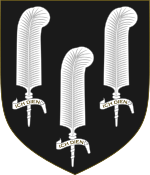
Here are the people who held the title while the Principality existed:
- Edward of Caernarfon, later Edward II (Prince from 1301 until he became King in 1307)
- Edward of Woodstock, the Black Prince (Prince from 1343 to his death in 1376)
- Richard of Bordeaux, later Richard II (Prince from 1376 until he became King in 1377)
- Henry of Monmouth, later Henry V (Prince from 1399 until he became King in 1413)
- Edward of Westminster (Prince from 1454 until his death in 1471)
- Edward of the Sanctuary, later Edward V (Prince from 1471 until he became King in 1483)
- Edward of Middleham (Prince from 1483 to his death in 1484)
- Arthur Tudor (Prince from 1489 to his death in 1502)
- Henry Tudor, later Henry VIII (Prince from 1504 until he became King in 1509)
- Edward Tudor, later Edward VI (Prince from 1537 until he became King in 1547, the last Prince of Wales created before 1542)
Welsh Rebellions
Madog ap Llywelyn led a Welsh revolt in 1294–95 against English rule. He was declared "Prince of Wales" by his supporters.
Owain Lawgoch, a relative of Llywelyn ap Gruffudd, claimed the title while living in France. His supporters rebelled across Wales between 1372 and 1378. He was killed before he could return to Wales to lead them.
Owain Glyndŵr was crowned at Machynlleth in 1404 during a revolt against Henry IV of England. He claimed to be a descendant of Rhodri Mawr. He made agreements with other countries and freed Wales from English rule for a time. However, he was eventually defeated and forced to lead a guerrilla war from the mountains. No one knows when or where he died. It is believed he died disguised as a friar with his daughter, Alys.
Laws in Wales Acts (1535 and 1542)
The Principality stopped being a separate legal entity when the English parliament passed the Laws in Wales Acts in 1535 and 1542. Wales had no representatives in this parliament. The law stated that Wales was already 'joined, united, and subject to the imperial Crown of this Realm'. English law became the only law in Wales. Justices of the peace managed the new counties. The act also made English the only language used in Welsh courts. Wales gained representation in the English parliament. However, people who only spoke Welsh could not hold office in the king's territories. The act was fully put into action with a more detailed law in 1543.
Wales After 1543: Joining England
Later Government in Wales
The Encyclopaedia of Wales notes that the Council of Wales and the Marches was created in 1471. It was meant to manage the Prince of Wales's lands and money. In 1473, it was expanded to also keep law and order in the Principality and the border areas of Wales. Its meetings were not regular, but Henry VII brought it back for his heir, Prince Arthur.
The Council became official by law in 1543. It played a key role in organizing law and government. The council at Ludlow had full administrative and legal powers. It declined in the early 1600s and was ended by Parliament in 1641. It was brought back after the Restoration but was finally abolished in 1689.
From 1689 to 1948, there was no difference between the governments of England and Wales. All laws for England also included Wales. The British Government saw Wales as an inseparable part of England within the United Kingdom. The first law specifically for Wales was the Sunday Closing (Wales) Act 1881. Another exception was the Welsh Church Act 1914. This law separated the Church in Wales from the Church of England in 1920.
In 1948, a new practice began. All laws passed in the Parliament of the United Kingdom were marked as applying to either "England and Wales" or "Scotland". This gave Wales a legal identity again, which it had not had for hundreds of years. Also in 1948, a new Council for Wales was set up as a parliamentary committee. In 1964, the Welsh Office was created in London. Its job was to oversee and suggest improvements for how laws were applied in Wales. This continued until the government in Wales gained more power. The independent National Assembly for Wales was established in 1998.
Other Uses of the Term "Principality"
Even though no principality has ever covered all of Wales, the word "Principality" has sometimes been used to mean Wales since the 1500s. For example, the first atlas of Wales in 1718 was called The Principality of Wales exactly described .... The term is still used by some publications today.
However, in modern times, The Guardian newspaper advises writers to "avoid the word 'principality'" when talking about Wales. The International Organization for Standardization (ISO) has called Wales a "country" since 2011. This followed a recommendation from the British Standards Institute and the Welsh Government.
Using the term "Principality" for the land of Wales is different from using it for the title of Prince of Wales. This title is traditionally given to the heir apparent of the British monarch. It does not give any power to govern Wales and has no official meaning. The Welsh political party Plaid Cymru wants to get rid of the title completely. The Honours of the Principality of Wales are the Crown Jewels used when Princes of Wales are officially recognized.





